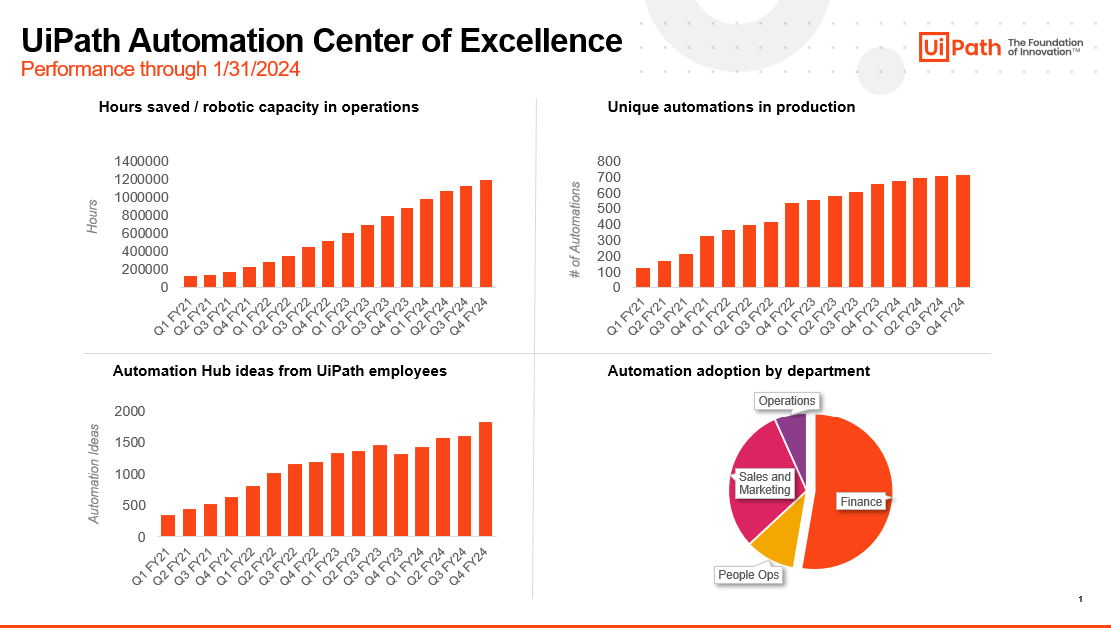Five lessons learned in implementing AI and automation: The FY24 Q4 report from the UiPath Automation CoE
Five lessons learned in implementing AI and automation: The FY24 Q4 report from the UiPath Automation CoE

AI has been a trending topic for over a year, and it has emerged as a strategic priority for companies in 2024. The EY CEO Outlook Pulse survey found that the vast majority of companies (88%) will invest in AI-driven innovation by the end this year.
AI-fueled innovation is truly a part of the UiPath DNA. We have been leveraging AI throughout our platform since our inception, and our use of it has only intensified over the past two years. To cite just a few examples, AI powers our process, task, and communications mining capabilities and enables our robots to understand and work with complex documents across many different systems and environments. Generative AI has enabled a broad array of recent innovations—for example, to speed up automation building, test development, and model training.
As a leader of the UiPath Automation Center of Excellence, I have first-hand knowledge of the benefits that our platform’s AI-powered capabilities can deliver. These include:
Ability to automate a broader array of processes
Faster and simpler ways to build higher-quality automations
Higher automation adoption and broader impact—especially thanks to enabling employees with UiPath Autopilot™, a personal AI companion that helps with tedious tasks across business apps and systems
The AI-powered capabilities woven throughout the UiPath Business Automation Platform have helped us deliver some very positive results for our quarterly CoE report card. At the end of full fiscal year 2024 (FY24) we had 716 automations operating, which freed up 70,677 hours in the last quarter of FY24. As a result, we have now surpassed $59 million in cumulative cost avoidance and are seeing results in a range of areas, including Finance, Sales & Marketing, People Ops, and Operations. And I’m excited to say that automation ideas coming from UiPathers and captured in Automation Hub continued to grow to a new high.

But these numbers aren’t the whole story, because they only capture our performance—what we have accomplished. They don’t talk about how we have made this happen—but for many of our customers, how to get things done is the most important part of the story. After all, in a recent UiPath and Bain & Company study, “The State of AI-Powered Automation,” 70% of executives asserted that AI-driven automation is either “very important” or “critical” in fulfilling their organization’s strategic objectives. With strategic advantage and competitiveness at stake, it’s no wonder that AI and automation implementation is such a consuming topic for so many of our customers.
For that reason, I’ll spend the remainder of this blog focusing on some of the important lessons we’ve learned in implementing AI and automation and getting real value at maximum speed from these two transformative technologies.
To illustrate our learnings, I’ll be focusing on a major process in our finance department, accounts payable. Every month the accounts payable team receives almost a thousand invoices that need to be reviewed and paid on time. This requires opening and reading submitted invoices, extracting the necessary data, matching it with existing purchase orders, and opening it in our system to proceed with payment. Done manually, this is a repetitive task that demands close attention to detail and diverts many person-hours each month away from higher-value work. In other words, it represented a perfect opportunity to let our robots take on the task.
At its heart, this was an intelligent document processing (IDP) project, requiring that we leverage UiPath Document Understanding. That's the AI that enables our UiPath Robots to read and understand complex, varied documents and take end-to-end action across multiple systems, departments, and technologies. (For more on our IDP capabilities, click here).
We focused on five things to ensure a successful outcome for this project.
Five elements of successful AI implementation
1. Close collaboration between the CoE and the business team
Successful automation implementation relies on strong partnership between the CoE and the business team. Automation can’t happen in a vacuum; it must reflect and be informed by the business users who know the processes and systems and will ultimately be the users and beneficiaries of the automation.
With 32% of its workforce consisting of digital assistants, the finance and accounting team is leading the way in adopting automation at UiPath. For this project, we turned to our finance colleagues to help us identify the key stages of the accounts payable process and provide all necessary details for building an automation and training the AI model. This included insights into the types of invoices they typically receive, the specific information they need to extract, and other pertinent details.
We also sought information to help us look beyond the existing process flow to identify optimization opportunities and streamline operational efficiency. They gave us insights into the overall process of creating invoices in Coupa and opened our eyes to the possibility of targeting other automated flows, such as e-Invoicing, all within the wider business context.
2. Measuring success beyond the “standard” automation KPIs
In collaboration with the finance team, we identified a set of metrics to measure the success of our automation project that went far beyond traditional automation KPIs like hours saved, cost reduction, or increased output accuracy. We wanted yardsticks that assessed the project’s impact on business efficiency, and were squarely aligned with the broader financial metrics by which we measure our company’s performance.
For this project, we focused mainly on a granular set of measures that could reveal automation’s direct impact on operational efficiency. These included tracking before-and-after invoice processing time, cost per invoice processed, first-time match rate, PO and invoice exception rate, and electronic processing rates.
3. Proactively communicating with the business and leadership teams
As we worked with the finance team, we provided a detailed action plan, so our colleagues had visibility into project phases, deadlines, key roles, and action items for them.
At the same time, we provided a high-level project overview to our executive sponsors and key stakeholders to outline our vision. As part of that, we made sure we communicated the potential positive impact of the project on key financial metrics that these executives are responsible for delivering. We wanted to make sure our executive sponsors could comprehend how this automation could help them meet their KPIs—and thus, deliver value to the company as a whole.
4. Reducing errors and ensuring high accuracy with AI best practices
Ensuring data accuracy is one of the key tasks of this automation, and there are two factors contributing to it—automation with an AI model, and human validation. When it comes to training an AI model, you need to make sure you have a large and diverse sample data to maximize the training efficiency.
In our case, we supplied the out-of-the-box Document Understanding model with our own types of invoices and trained it to identify and extract data in various scenarios. We also tested the model with different data volumes, simulated peak periods, and assessed its accuracy under different settings. Moreover, using UiPath Action Center, we built a human validation process into the automation workflow to enable our finance colleagues to step in as necessary and assist the AI model.
While extensive training of an AI model used to be a stumbling block in implementing IDP—taking weeks or months of business users’ time—we found that the process was much shorter and easier than our going-in assumptions. That’s because we were able to use our new Active Learning capability, which combines elements of both supervised and unsupervised learning to create better AI models in less time. (Learn more about how Active Learning accelerates AI automation here.)
5. Continuous monitoring and improvement
We've learned that we can't stop once an AI-powered automated process is deployed. For this project, we continued to work in partnership with the finance team to monitor results and collect feedback for the next iterations. Implementing a feedback and learning loop ensures a continuous cycle of improvement wherein new insights are used to refine the automation process, enhance model accuracy, and drive even bigger business impact.
These five lessons have been central to our ability to deliver high-performing automations and get real value from AI. But wait—there’s one more thing that added greatly to our ability to deliver this project effectively and quickly. So, here’s a bonus idea for reading this far:
(Bonus tip) Leveraging prebuilt components
We’ve found that implementing end-to-end automation projects doesn't have to be a complex and lengthy process—particularly if we can use some of our 70+ Solution Accelerators. These are prebuilt, modular frameworks tailored for high impact use cases and incorporate industry and our own best practices. With these ready-to-go components in our arsenal, it’s much easier to move quickly to deliver high-performing automation outcomes.
As an example, for our accounts payable project, we used the ‘2-way match invoice processing for Coupa’ accelerator. This eliminated a lot of custom development, while also ensuring a high-quality solution for this part of the automation. (Another bonus: we were also able to pressure-test this accelerator and identify ways to improve it even further. Moving forward, we’ll release an updated version that will incorporate insights gained from our implementation experience.)
These are some of the most important practices we’ve developed for implementing AI and automation. But you can learn a lot more from the CoE-focused content UiPath shared during our recent DevCon event—which you can now see on demand by registering here.
The road ahead for the UiPath CoE
I’d like to close this blog with a quick look at some exciting developments for the UiPath CoE. As you may be aware, last year, UiPath and SAP extended their partnership to enable organizations across the globe to accelerate their digital transformation. This January, UiPath and Deloitte announced an alliance expansion to create a first-of-its-kind co-innovation market collaboration, combining Deloitte’s SAP implementation skillset and deep AI talent pool with UiPath AI and automation technology.
The UiPath CoE will be ‘customer zero’ in this Deloitte-UiPath collaboration, and I am very excited about what we will learn and what new things we’ll be able to do. I look forward to sharing our learnings and innovations with you. Stay tuned!

Senior Director, CoE, UiPath
Get articles from automation experts in your inbox
SubscribeGet articles from automation experts in your inbox
Sign up today and we'll email you the newest articles every week.
Thank you for subscribing!
Thank you for subscribing! Each week, we'll send the best automation blog posts straight to your inbox.



